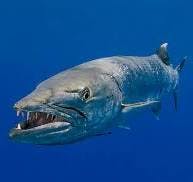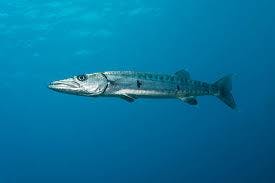Understanding Barracuda: Characteristics and Potential Threat to Humans
Barracudas are among the most intriguing yet feared predators inhabiting tropical and subtropical oceans worldwide. Their sleek, torpedo-shaped bodies, razor-sharp teeth, and remarkable speed make them formidable hunters. In this exploration, we delve into the world of barracudas, examining their characteristics, behaviors, and whether they pose a significant threat to humans.

The razor sharp teeth of a barracuda
Anatomy and Characteristics
Barracudas belong to the Sphyraenidae family and encompass around 20 species, with the great barracuda (Sphyraena barracuda) being the most renowned. They typically exhibit elongated, silver bodies with dark, horizontal stripes along their sides, aiding in camouflage and ambushing prey. Their distinctive features include a large mouth filled with dagger-like teeth, excellent eyesight, and a streamlined body built for swift movement.
These predators can reach impressive lengths, with some species exceeding six feet (2 meters) in length and weighing over 100 pounds (45 kilograms). Their muscular bodies enable them to achieve astonishing speeds, reaching up to 35 miles per hour (56 kilometers per hour) in short bursts, making them efficient ambush predators.
Habitat and Distribution
Barracudas inhabit warm, coastal waters across the globe, favoring coral reefs, seagrass beds, and shallow coastal areas. They thrive in tropical and subtropical regions, including the Caribbean Sea, the Gulf of Mexico, the Indian Ocean, and the Pacific Ocean. Their adaptability allows them to dwell in a variety of marine environments, from mangrove forests to open ocean waters.
Behavior and Predatory Tactics
Barracudas are solitary hunters known for their stealth and agility. They often lurk near coral reefs or underwater structures, patiently waiting for prey to pass by. Their hunting strategy involves sudden bursts of speed, during which they ambush unsuspecting fish with lightning-fast strikes. Barracudas primarily feed on smaller fish, including mullet, jacks, and herrings, using their sharp teeth to inflict fatal wounds.
Despite their aggressive reputation, barracudas typically do not pose a threat to humans unless provoked or cornered. They are naturally curious creatures, occasionally drawn to shiny objects or reflective surfaces. However, attacks on humans are rare and usually occur under specific circumstances, such as mistaken identity or territorial defense.
Potential Threat to Humans
While barracudas generally avoid human interaction, encounters can occur, especially in areas where humans engage in snorkeling, diving, or spearfishing. Most incidents involving barracudas result from misunderstandings or defensive reactions rather than deliberate aggression. Provocation, such as attempting to handle or feed barracudas, can escalate the risk of an encounter.
Barracuda attacks on humans typically involve swift, opportunistic strikes, often resulting in superficial lacerations or puncture wounds. Although barracudas possess powerful jaws and sharp teeth capable of inflicting significant damage, fatalities from barracuda attacks are exceedingly rare. Most injuries are minor and occur when humans inadvertently provoke or startle the fish.

The long slender body of the barracuda
Preventive Measures and Safety Guidelines
To minimize the risk of barracuda encounters, individuals should adhere to safety protocols and exercise caution when swimming or diving in barracuda-inhabited waters. The following preventive measures can help mitigate potential risks:
- Avoid provoking or harassing barracudas, as they may perceive humans as threats and respond defensively.
- Refrain from wearing shiny jewelry or reflective objects that may attract barracudas’ attention.
- Maintain a safe distance from barracudas and respect their natural habitat.
- If approached by a barracuda, remain calm and avoid making sudden movements.
- Do not attempt to hand-feed barracudas or offer them food, as this can encourage aggressive behavior.
In conclusion, barracudas are fascinating marine predators renowned for their speed, agility, and predatory prowess. While they possess the capability to inflict harm on humans, barracuda attacks are rare and typically occur under specific circumstances. By understanding their behavior and respecting their natural habitat, humans can coexist safely with these remarkable creatures, fostering a deeper appreciation for the diverse ecosystems they inhabit. Through education, awareness, and responsible interaction, we can promote harmony between humans and barracudas in the vast expanse of the world’s oceans.
